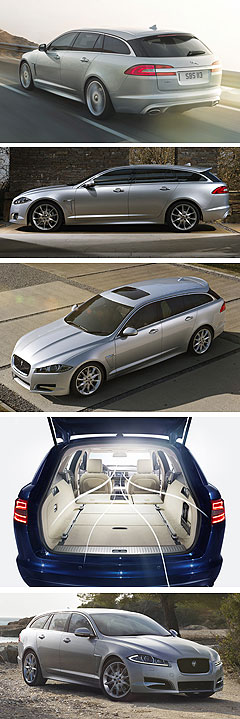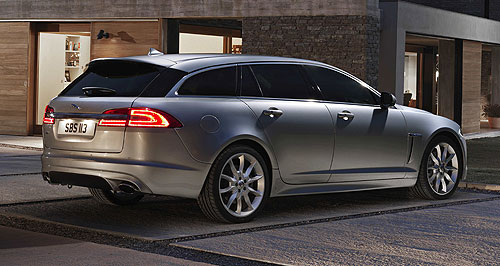Make / Model Search
Future models - Jaguar - XF - SportbrakeGeneva show: Jaguar reveals XF SportbrakeWagon trail: The high-waisted Jaguar XF Sportbrake will likely come to Australia in about a year from now. Sleek new wagon version of Jaguar’s XF sedan breaks as all-diesel Sportbrake1 Mar 2012 JAGUAR has revealed its forthcoming XF Sportbrake – a wagon version of the acclaimed XF saloon – ahead of its official unveiling next Tuesday at the Geneva auto show. The sleek XF wagon is expected to go on sale in Europe in the third quarter of this year, so expect an Australian launch late this year or in early 2013. Jaguar Australia brand manager Kevin Goult said the company is still reviewing the Sportbrake, but is confident it will reach the local market. “We’ve been reviewing it for a while, looking at the business case and then the ADR (Australian Design Rules) compliance, but we have the intention of making it available in Australia,” Mr Goult told GoAuto. Mr Goult said the car would be available for retail order in Australia but would not be held in stock. Pricing is still being discussed with head office, but is expected to be about seven per cent higher than the sedan, which would make the entry-level 2.2D model about $92,000. Jaguar will market the XF Sportbrake exclusively with diesel engines – the existing 2.2-litre four-cylinder turbo and the 3.0-litre twin-turbo V6 – because it is essentially designed for the diesel-dominated European market, where wagon uptake is as much as 30 per cent. Named after the traditional English name for a wagon – shooting brake – the Sportbrake is completely new from the B-pillar back and was again styled by Jaguar design icon Ian Callum. Although only 5mm longer (at 4966mm), it is reportedly about 70kg heavier than the XF sedan, which was launched in 2008.  Jaguar claims the wagon matches the sedan for aerodynamics, torsional stiffness and dynamic ability. Jaguar claims the wagon matches the sedan for aerodynamics, torsional stiffness and dynamic ability.Luggage capacity with the 60:40 split-fold rear seats down is 1675 litres, while the similarly styled Holden Commodore Sportwagon consumes as much as 2000 litres of cargo in the rear. The tailgate has a ‘soft-close’ function as standard and can also be specified with a powered open/close function, while other extras include internal floor rails and external roof rails. Jaguar claims the load area is not only long (1970mm) but wide enough for sideways stowage of golf clubs. The rear seatbacks can be reclined using one-touch remote levers situated just inside the tailgate while a small stowage area at the side includes a built-in torch. To handle the extra load-carrying capacity, Jaguar has installed a new air suspension system (in place of coil springs) with a self-levelling function designed to keep the car level when fully laden while offering the same ride and handling attributes as the sedan. If that’s not enough to appease sporty drivers, Jaguar will also offer an optional ‘Adaptive Dynamics’ system with active dampers able to adjust themselves up to 500 times a second to provide the ultimate combination of comfort and handling. A higher roofline and new rear seat makes the Sportbrake a proper five-seater for adults, providing an extra 48mm of headroom in the back compared with the coupe-like XF sedan. Jaguar Design studio director Wayne Burgess said the Jaguar design philosophy is based on the smooth, uninterrupted flow of lines that lead the eye along and around the vehicle and that this is readily apparent in the XF Sportbrake which, despite sharing an identical wheelbase with the saloon, “is imbued with even greater presence”. “Creating the Sportbrake was a great opportunity for us to extend the XF’s design aesthetic,” he said. “The flow and connection of lines that lead the eye around the car result in an entirely practical estate car consistent with Jaguar’s reputation for drama and elegance. “The first of the elegantly simple feature lines begins in the propeller-inspired blades fitted to the side air intakes, leading the eye into the lower wing crease and then along the sills of the car and around the rear bumper. “The second feature line runs up from the outer edge of the same intakes, defining the edges of the front wings before wrapping the entire way around the car, creating the XF Sportbrake’s muscular shoulder line. “The clever conjunction of the side window graphic tapering down to meet the rising shoulder line not only emphasises the XF Sportbrake’s strong haunches but also helps the rear roofline appear to taper elegantly towards the tail. “This impression of fluidity is heightened by the use of gloss black finishers on the rear pillars, providing a wraparound effect in conjunction with the tinted rear screen, an aesthetic inspired by the superstructures of luxury yachts.” An optional ‘Aero Pack’ (standard on the top S model) adds a deeper front bumper, side sills and rear valance plus a rear spoiler enhancement, though a tailgate spoiler is standard on all models. A ‘Black Pack’ replaces the exterior bright finishes with gloss black and pairs them with similarly finished alloy wheels. Mechanically, the 140kW/450Nm 2.2-litre turbo-diesel is linked to an eight-speed automatic transmission and idle-stop system in the XF Sportbrake while the 3.0-litre twin-turbo V6 diesel comes in two power outputs (177kW/500Nm and 202kW/600Nm), also linked to the eight-speed auto. Jaguar Cars global brand director Adrian Hallmark said the XF Sportbrake extends the acclaimed sporting saloon’s versatility and practicality. “The XF epitomises the Jaguar sporting dynamic with its combination of innovative, seductive design and performance,” he said. “In the XF Sportbrake, this is complemented by a no-compromise approach to practicality and versatility.”  Read more15th of December 2011  Jaguar teases XF ‘Sportbrake’ wagonFestive spirit abounds as Jaguar issues humorous ‘spy’ shot of upcoming XF wagonAll future models Alfa Romeo Alfa Romeo Abarth Abarth Alpine Alpine Alpina Alpina Audi Audi Aston Martin Aston Martin BMW BMW Bentley Bentley Chery Chery Brabham Brabham Chrysler Chrysler Chevrolet Chevrolet Cupra Cupra Citroen Citroen DS DS Dodge Dodge Fiat Fiat Ferrari Ferrari Foton Foton Ford Ford Great Wall Great Wall FPV FPV Haval Haval GWM GWM Honda Honda Holden Holden Hummer Hummer HSV HSV Infiniti Infiniti Hyundai Hyundai Jaguar Jaguar Isuzu Isuzu Kia Kia Jeep Jeep Land Rover Land Rover Lamborghini Lamborghini Lexus Lexus LDV LDV Mahindra Mahindra Lotus Lotus Mazda Mazda Maserati Maserati Mercedes-AMG Mercedes-AMG McLaren McLaren MG MG Mercedes-Benz Mercedes-Benz Mitsubishi Mitsubishi Mini Mini Opel Opel Nissan Nissan Peugeot Peugeot Pagani Pagani Proton Proton Porsche Porsche Renault Renault Ram Ram Rover Rover Rolls-Royce Rolls-Royce Skoda Skoda Saab Saab SsangYong SsangYong Smart Smart Suzuki Suzuki Subaru Subaru Toyota Toyota Tesla Tesla Volvo VolvoXF pricing
Motor industry news |
Click to shareJaguar modelsResearch Jaguar All future models Alfa Romeo Alfa Romeo Abarth Abarth Alpine Alpine Alpina Alpina Audi Audi Aston Martin Aston Martin BMW BMW Bentley Bentley Chery Chery Brabham Brabham Chrysler Chrysler Chevrolet Chevrolet Cupra Cupra Citroen Citroen DS DS Dodge Dodge Fiat Fiat Ferrari Ferrari Foton Foton Ford Ford Great Wall Great Wall FPV FPV Haval Haval GWM GWM Honda Honda Holden Holden Hummer Hummer HSV HSV Infiniti Infiniti Hyundai Hyundai Jaguar Jaguar Isuzu Isuzu Kia Kia Jeep Jeep Land Rover Land Rover Lamborghini Lamborghini Lexus Lexus LDV LDV Mahindra Mahindra Lotus Lotus Mazda Mazda Maserati Maserati Mercedes-AMG Mercedes-AMG McLaren McLaren MG MG Mercedes-Benz Mercedes-Benz Mitsubishi Mitsubishi Mini Mini Opel Opel Nissan Nissan Peugeot Peugeot Pagani Pagani Proton Proton Porsche Porsche Renault Renault Ram Ram Rover Rover Rolls-Royce Rolls-Royce Skoda Skoda Saab Saab SsangYong SsangYong Smart Smart Suzuki Suzuki Subaru Subaru Toyota Toyota Tesla Tesla Volvo VolvoXF pricing
Motor industry news |











Facebook Twitter Instagram